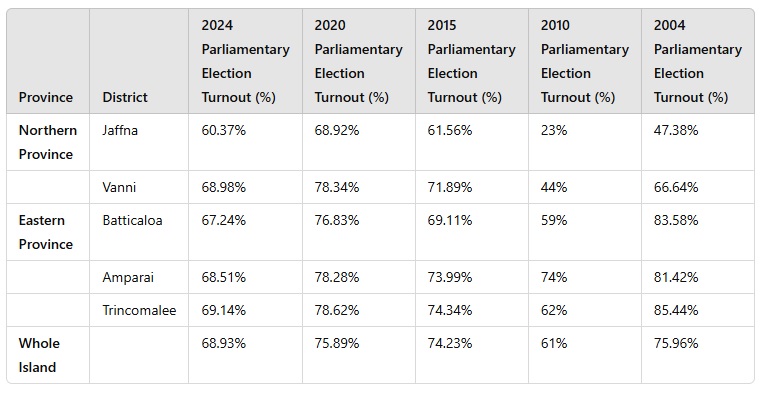.jpeg)
Even though hundreds of thousands of Tamils took to the polls on Thursday, turnout remained historically low for the Tamil homeland.
According to figures released by the Election Commission of Sri Lanka, turnout for the North-East was recorded as below.

Figures slight dropped or matched the rest of the island, but were significant lower in Jaffna.
How does this compare with the Tamil vote historically?

In comparison to the previous two parliamentary polls, turnout was lower in every district in the North-East.
The 2020 parliamentary elections were held a year into the presidency of Gotabaya Rajapaksa, whilst the 2015 elections took place under the presidency of Maithripala Sirisena.
Looking back further to 2010 and the 2004 polls, the turnout has increased but both those elections were marred by the armed conflict and the aftermath of a genocide.

In April 2004, though a case fire was in places, tensions remained high. Just weeks before the polls. Karuna had defected from the LTTE and joined hands with the Sri Lankan state, with his cadres in the East reportedly engaged in forced recruitment and other human rights violations, with the aid of the Sri Lankan army.
The 2010 elections took place less than a year after the Mullivaikkal genocide, in which tens of thousands of Tamils were slaughtered by the Sri Lankan state. The period saw hospitals repeatedly bombed, widespread sexual violence and the execution of those who surrendered to the army.
Read more: 15 years today - A massacre in Mullivaikkal
How does this compare with the Tamil vote earlier this year?

A more recent comparison could be made to the presidential polls earlier this year, which only took place in September.
Though the nature of the elections are different – voting for local representatives rather than a head a state – turnout was still lower across every district and the island as a whole.
The 2024 election a record number of candidates stood for election this year. In Jaffna and Vanni alone, more than 800 candidates from hundreds of political parties stood for just 12 seats. In the East, more than 1,200 candidates vied for their 16 seats.


